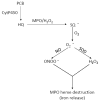Exposure to polychlorinated biphenyls enhances lipid peroxidation in human normal peritoneal and adhesion fibroblasts: a potential role for myeloperoxidase
- PMID: 20067832
- PMCID: PMC2834263
- DOI: 10.1016/j.freeradbiomed.2010.01.005
Exposure to polychlorinated biphenyls enhances lipid peroxidation in human normal peritoneal and adhesion fibroblasts: a potential role for myeloperoxidase
Abstract
Nitric oxide, superoxide, and lipid peroxidation (LPO) produced under oxidative stress may contribute to the development of postoperative adhesions. The objective of this study was to determine the effects of polychlorinated biphenyls (PCBs) on LPO, superoxide dismutase, myeloperoxidase (MPO), and nitrite/nitrate in human normal peritoneal and adhesion fibroblasts. PCB treatment reduced inducible nitric oxide synthase (iNOS) expression as well as levels of nitrite/nitrate in both cell lines. Although there was no difference in iNOS expression between the two cell lines, adhesion fibroblasts manifested lower basal levels of MPO compared to normal peritoneal fibroblasts. There was a reduction in MPO expression and its activity in response to PCB treatment in normal peritoneal fibroblasts; however, this effect was minimal in adhesion fibroblasts. Moreover, adhesion fibroblasts manifested higher levels of LPO compared to normal peritoneal fibroblasts, whereas PCB treatment increased LPO levels in both cell types. We conclude that PCBs promote the development of the adhesion phenotype by generating an oxidative stress environment. This is evident by lower iNOS, MPO, and nitrite/nitrate and a simultaneous increase in LPO. Loss of MPO activity, possibly through a mechanism involving MPO heme depletion and free iron release, is yet another source of oxidative stress.
Copyright 2010 Elsevier Inc. All rights reserved.
Figures






Similar articles
-
The role of myeloperoxidase in the pathogenesis of postoperative adhesions.Wound Repair Regen. 2009 Jul-Aug;17(4):531-9. doi: 10.1111/j.1524-475X.2009.00500.x. Wound Repair Regen. 2009. PMID: 19614918
-
Shifting anaerobic to aerobic metabolism stimulates apoptosis through modulation of redox balance: potential intervention in the pathogenesis of postoperative adhesions.Fertil Steril. 2015 Oct;104(4):1022-1029. doi: 10.1016/j.fertnstert.2015.06.041. Epub 2015 Jul 26. Fertil Steril. 2015. PMID: 26215756
-
Role of nitric oxide in apoptosis of human peritoneal and adhesion fibroblasts after hypoxia.Fertil Steril. 2004 Oct;82 Suppl 3:1198-205. doi: 10.1016/j.fertnstert.2004.04.034. Fertil Steril. 2004. PMID: 15474096
-
PCBs enhance collagen I expression from human peritoneal fibroblasts.Fertil Steril. 2008 Oct;90(4 Suppl):1372-5. doi: 10.1016/j.fertnstert.2007.07.1380. Epub 2007 Sep 20. Fertil Steril. 2008. PMID: 17888429 Free PMC article.
-
Free Radical Lipid Peroxidation Induced by Reactive Halogen Species.Biochemistry (Mosc). 2024 Jan;89(Suppl 1):S148-S179. doi: 10.1134/S0006297924140098. Biochemistry (Mosc). 2024. PMID: 38621749 Review.
Cited by
-
Transcriptome sequencing analysis of primary fibroblasts: a new insight into postoperative abdominal adhesion.Surg Today. 2022 Jan;52(1):151-164. doi: 10.1007/s00595-021-02321-6. Epub 2021 Jun 12. Surg Today. 2022. PMID: 34120243
-
Nicotinamide Adenine Dinucleotide Phosphate Oxidase Expression Is Differentially Regulated to Favor a Pro-oxidant State That Contributes to Postoperative Adhesion Development.Reprod Sci. 2014 Aug;21(8):1050-1059. doi: 10.1177/1933719114522524. Epub 2014 Feb 10. Reprod Sci. 2014. PMID: 24516041 Free PMC article.
-
Polychlorinated Biphenyls Induce Oxidative DNA Adducts in Female Sprague-Dawley Rats.Chem Res Toxicol. 2016 Aug 15;29(8):1335-1344. doi: 10.1021/acs.chemrestox.6b00146. Epub 2016 Jul 20. Chem Res Toxicol. 2016. PMID: 27436759 Free PMC article.
References
-
- Saed GM, et al. Regulation of inducible nitric oxide synthase in post-operative adhesions. Hum Reprod. 2006;21(6):1605–11. - PubMed
-
- Khaitan D, Dwarakanath BS. Endogenous and induced oxidative stress in multi-cellular tumour spheroids: implications for improving tumour therapy. Indian J Biochem Biophys. 2009;46(1):16–24. - PubMed
-
- Hileman EO, et al. Intrinsic oxidative stress in cancer cells: a biochemical basis for therapeutic selectivity. Cancer Chemother Pharmacol. 2004;53(3):209–19. - PubMed
-
- Cheng G, et al. Homologs of gp91phox: cloning and tissue expression of Nox3, Nox4, and Nox5. Gene. 2001;269(1–2):131–40. - PubMed
Publication types
MeSH terms
Substances
Grants and funding
LinkOut - more resources
Full Text Sources
Research Materials
Miscellaneous

